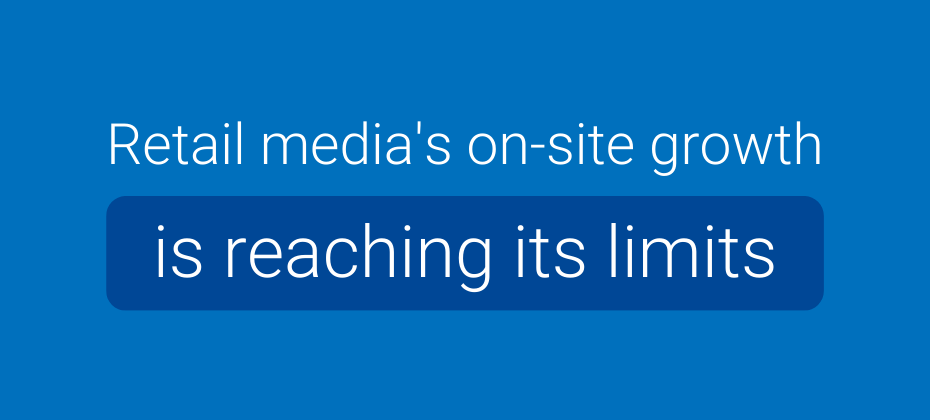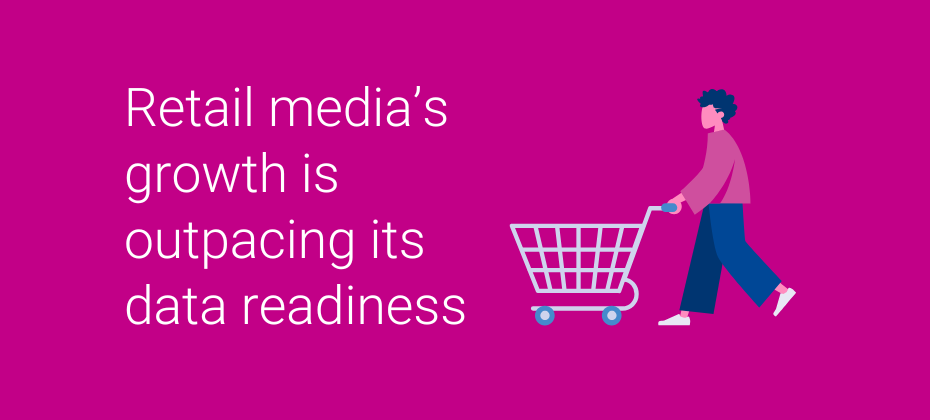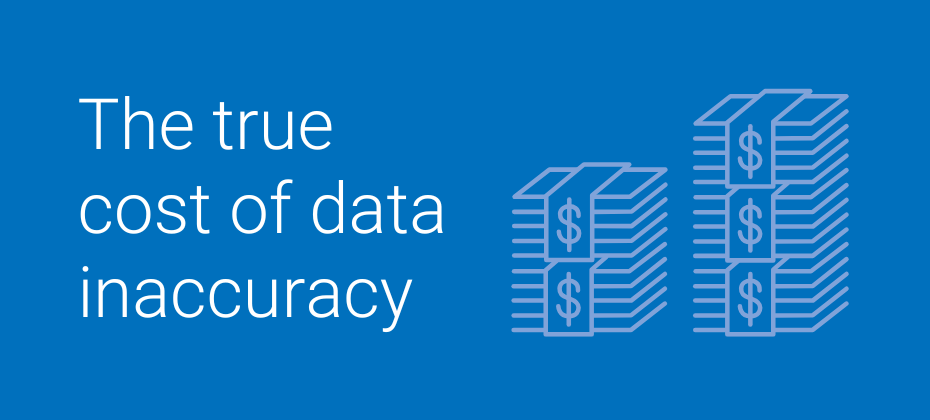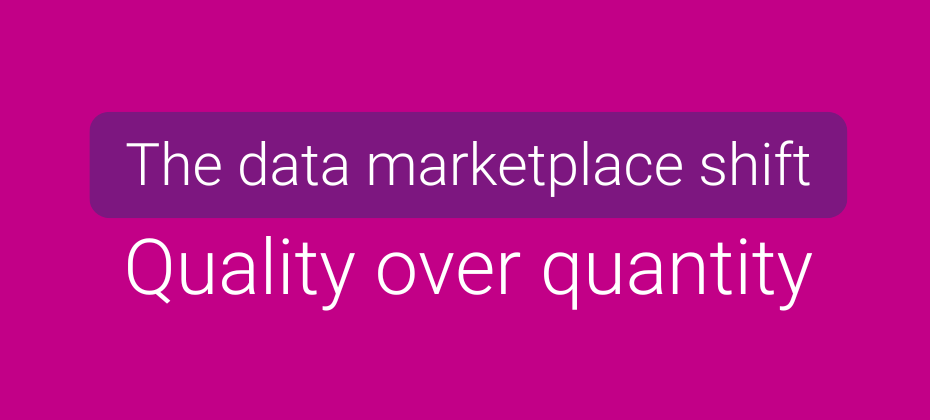All posts by Hayley Schneider, Content Marketing Manager

Retail media networks (RMNs) are on the brink of a major shift. While they are poised to capture over 20% of ad spend in 2025, on-site monetization won't be the growth driver it once was. With advertisers consolidating spend among just six or seven RMNs on average, including giants like Amazon and Walmart, it’s hard for smaller RMNs to compete. Off-site retail media ad spend is projected to grow 42.1% in 2025—nearly three times the rate of on-site growth (15.1%), according to eMarketer's November 2024 forecast. This dramatic shift underscores that while on-site placements are maturing, off-site is where the momentum (and money) is heading. To remain competitive, RMNs must move beyond traditional, on-site placements and embrace a broader, more integrated approach to media activation. The future of retail media is about utilizing enriched first-party data to drive performance across the open web, connected TV (CTV), and other digital channels. Break free from your owned and operated properties Historically, RMNs have limited ad placements to their own digital properties. While this approach has delivered high-margin returns—on-site ad margins can reach 70-90%, compared to 20-40% for off-site—it’s also inherently limiting. Retailers only have so much owned inventory to sell, and advertisers demand greater scale and flexibility. As brands push for more reach, RMNs must extend their impact beyond owned-and-operated (O&O) properties. Omnichannel retail media ad spending is forecast to hit $61.2 billion in 2025. Brands are looking beyond retail sites to build integrated, multi-channel strategies that drive results across the funnel.eMarketer Off-site doesn’t just mean digital. Walmart’s recent expansion of its Fuel and Convenience stations - planning to open or remodel 45 in 2025, bringing the total to 450 - shows how physical spaces are also becoming extensions of a retailer’s media network. These locations create new touchpoints where advertisers can engage shoppers with timely, context-aware messaging while they fuel up or grab a snack. These quick-stop environments are ideal for limited-time offers or impulse-triggering messages—especially since 68% of U.S. adults say discounts contribute to their latest in-store impulse purchase. Maximize the value of first-party data One of retail media’s biggest promises is the power of first-party data for precision targeting. While on-site ads are inherently lower-funnel, off-site activation allows advertisers to move up the funnel and apply retailer customer data holistically across the open web. For example, DoorDash and Macy’s now offer self-service audience data to advertisers via The Trade Desk, allowing brands to target consumers programmatically. Meanwhile, Walmart is taking a different approach—cloning The Trade Desk’s technology to maintain its walled garden. These moves demonstrate how retailers are rethinking data monetization strategies to scale beyond O&O limitations. Drive new revenue streams with off-site activation Off-site activation enables RMNs to drive incremental reach on channels where audiences are actively engaging, including CTV, programmatic display, and social media. This expansion allows brands to connect with consumers beyond retail websites. Retailers are also utilizing non-endemic advertising opportunities in environments like gas stations and kiosks Unlike traditional grocery or apparel aisles, these spaces are brand-neutral, allowing advertisers who don’t sell products in-store to still activate campaigns using retailer data. In fact, 53% of brands have already partnered with a retailer that doesn’t carry their product, and that number is expected to grow as advertisers seek new ways to tap into retail media’s rich targeting capabilities. Retailers looking to extend the value of their data beyond O&O inventory have two primary off-site opportunities: First, they can use an identity graph to resolve customer identifiers into addressable IDs that can be enriched with additional attributes and activated across channels like the open web and CTV. This allows retailers to find and reach known customers with relevant messaging outside of their owned platforms. For example, a grocery RMN can identify lapsed snack buyers and deliver streaming TV ads that reengage them on CTV platforms. CTV retail media ad spending alone is expected to grow 43.1% this year, reaching $4.86 billion, highlighting the appetite for video-based upper-funnel strategies. Second, RMNs can broaden reach by activating first-party audiences, syndicated segments, or custom-built audiences through onboarding capabilities. These audiences can be sent to a variety of programmatic and CTV destinations, enabling advertisers to engage shoppers in high-impact environments. For example, a home improvement retailer can send its audience segments to programmatic ad exchanges, ensuring DIY shoppers see relevant offers even while browsing unrelated sites. Together, these approaches allow retailers to monetize their data more effectively while giving brands the ability to reach consumers in moments that matter beyond just retail websites and apps. Scale and measure success with data partnerships For smaller RMNs to compete with larger players, they need more than just inventory—they need the ability to scale campaigns and prove performance. Data partnerships play a critical role in both expansion and measurement. Measurement remains one of the biggest challenges for RMNs moving off-site. On-site retail media offers closed-loop attribution, but off-site activations introduce complexity. Retailers can work with an identity resolution partner like Experian to connect ad exposures to actual retail outcomes, such as store visits or purchases, across digital and physical environments. Whether it's through pixels placed on campaign ads or TV impression logs, these connections help RMNs demonstrate real impact. This approach helps unify disparate data—such as a CTV ad exposure and a subsequent online or in-store purchase—into a clear, measurable outcome. These insights not only show what’s working, but help RMNs optimize future campaigns and provide advertisers with transparent, third-party-validated reporting. As retailers like Walmart integrate loyalty programs like Walmart+ into their physical extensions, they gain valuable behavioral insights into how customers shop across formats—from fueling up to filling carts. These data signals help refine identity graphs and improve measurement across increasingly hybrid consumer journeys. Beyond ads: The data monetization opportunity Smaller RMNs may struggle to scale ad-supported revenue, but there’s another path forward: Data-as-a-Service (DaaS). Providing anonymized, privacy-compliant audience insights to brands offers a high-margin, scalable revenue stream. In fact, some retailers are already embracing this model by licensing their data to programmatic platforms. A playbook for smaller RMNs to win off-site The future of retail media belongs to those who harness data to influence consumer behavior across all digital marketing channels. To succeed, RMNs should focus on: Moving beyond owned inventory: Activate first-party data across CTV, social, and programmatic channels to meet advertisers where their audiences are. Expanding reach through partnerships: Collaborate with identity resolution providers to maximize match rates and campaign effectiveness. Building a full-funnel offering: Position off-site retail media as a brand-building play, tapping into ad budgets that traditionally fund upper-funnel campaigns. Monetizing data, not just ads: Explore DaaS models to generate passive revenue. The time to move off-site is now Retailers that wait too long to embrace off-site activation risk falling behind. Those that expand beyond their owned inventory, invest in off-site data strategies, and build strategic partnerships will be the ones that shape the future of retail media. Experian isn’t just part of the RMN conversation. We’re driving it. Let’s talk. Connect with our team Latest posts

Not all customers are the same, so why waste your budget marketing to them like they are? McKinsey research shows that 71% of consumers want personalized shopping experiences, and 76% get frustrated when they don’t have them. That’s where demographic segmentation comes in. But what is demographic segmentation, exactly? We define it as a process that helps you categorize your audience into meaningful demographic groups so you can reach the right people with impactful custom messages. Businesses across industries are partnering with Experian to power smarter decisions and better results through solutions like demographic segmentation — but what does this look like in action? This article breaks down five real-world demographic segmentation examples, showing how businesses have worked with us to drive measurable success so you can see exactly how it can work for you. What is demographic segmentation? Demographic segmentation involves dividing your audience into smaller, more specific groups based on shared demographics like income, education, gender, job, family status, and more to gain a more granular understanding of your brand’s target segments. The better you know your audience, the better you speak to their unique needs — and the more effective your campaigns will be, as you’ll be able to target each segment with highly personalized content that resonates. For instance, a company might market a new tech gadget to young adults in one way while promoting the same product to families with young children in a completely different way, ensuring the message speaks to each group’s lifestyle and priorities. Demographic segmentation attributes Some of the most common attributes used in demographic segmentation include: Age Each age group has different wants and needs. A new video game might catch the eye of teenagers, while a retirement plan is more likely to appeal to someone in their 50s or 60s. Gender Gender impacts preference for certain products, from fashion to gadgets, so knowing who you’re talking to helps make your marketing more relevant. Income Someone with a higher income might be more likely to purchase premium products, while someone on a budget will respond better to discounts or value-based offers. Education The level of education a person has can influence what kind of messaging will resonate with them, whether it’s complex or more straightforward. Occupation A marketing message targeting busy professionals might differ from one aimed at students or retirees. Occupation can tell you what’s important to a person in terms of their needs and lifestyle. Family Status A family with young kids likely has different priorities than a single person or a couple without children. You can adapt your messaging to be more relevant to what matters most to them, like convenience or value. Benefits of using demographic segmentation Demographic segmentation offers several valuable benefits for marketers. Here’s why it’s one of the most commonly used and effective ways to target audiences: Improved targeting and personalization: Demographic segmentation powers highly customized campaigns so you can cater to different income levels, family structures, job types, and so forth. B2C brands can provide offers based on factors like age, income, and gender, while B2B brands can target by occupation to reach decision-makers. Better product and service development: Understanding which demographics use your product or service is a great way to inform future improvements. Higher engagement: With highly customized content, you can speak directly to specific demographic groups and increase engagement. Cost efficiency: As you target the most relevant segments, you optimize your spending around the most likely buyers and will see better returns. Increased conversion and retention: Relevant, targeted messaging leads to higher conversion rates, and when people feel understood, they’ll want to keep coming back. Clearer customer insights: Demographic data provides precise, actionable insights for refining your marketing strategy. Simplicity and effectiveness: Demographic insights are immediately actionable and easy to implement, which gives you a great starting point for focused campaigns. When to use other segmentation types While demographic segmentation provides valuable consumer insights, there are times when other approaches may offer a more effective strategy: Your business provides location-dependent services. If you strictly serve a local area, geographic segmentation would be more effective in targeting customers based on location. Your business offers hobby-centric products or services. Psychographic segmentation (based on interests, lifestyle, or values) may be more relevant than demographics alone for products related to specific interests or hobbies. You have access to detailed behavioral data. If you collect data on customer behavior (like browsing history or purchase patterns), behavioral segmentation would allow for more personalized targeting than demographics. You're selling high-end luxury products. While income is a useful demographic variable, psychographic factors like values, aspirations, and lifestyle better capture the desires of luxury consumers. Your target audience shares similar behaviors, regardless of demographic factors. Behavioral or psychographic segmentation might offer more insight if your customers engage with your product or service based on shared behaviors rather than demographic traits. Your product or service targets specific needs or pain points. Segmenting by need or issue rather than traditional demographic variables would likely yield better results if you're offering a solution to a particular problem (like a health-related product). How our customers are using demographic segmentation to produce tangible results Demographic segmentation is about knowing your audience and using data to create marketing strategies that drive measurable outcomes. Let’s look at some real-world use cases from brands like yours that have been successful in this effort, working with Experian to translate demographic insights into significant business growth. Use case #1: Identifying customer spending potential to boost growth for a retail chain Objective A large retail chain wanted to understand the spending potential of each customer in their stores. Their goal was to uncover and maximize untapped spending potential. Solution Experian conducted an analysis to identify the top demographic factors that drove spending in the retail store the previous year. Our consultants found the four key drivers were: Age Income Family structure (household composition) Location/region Results By combining these attributes to create segments, we uncovered two valuable annual estimates: Potential spend: A conservative estimate of how much a customer could spend if they reached the top 20% of spenders within their specific demographic segment (based on data from the highest spenders). Unrealized spend: The difference between a customer's annual potential spend and their current spend. An estimate of how much more they could be spending each year. These demographic segments provided the marketing strategy the retail chain used to target $1.1 billion in unrealized spend. This revealed how much additional revenue could be captured by targeting the right customers with tailored marketing and offers through demographic segmentation. Use case #2: Helping a financial institution identify regional DE&I opportunities Objective A large financial institution needed help identifying regional diversity, equity, and inclusion (DE&I) opportunities. They wanted to better prioritize their outreach to underserved communities in the Los Angeles area. Solution Experian's Custom Analytics team provided the data and insights to pinpoint specific areas needing attention. We used three key indices to analyze the region: Income index: Measured each underserved economic group by comparing the percentage of low-to-moderate income consumers against the entire L.A. area. Ethnicity index: Measured the percentage of consumers by ethnicity, such as African-American, Hispanic, Asian, and others, against the entire L.A. area. Credit index: Identified potential credit disparities by looking at the average FICO score and the percentage of customers with credit accounts against the entire L.A. area. Results Our client received an analytics dashboard to track and report these metrics, providing clear, traceable data to prioritize DE&I outreach. This dashboard helped them measure progress toward more inclusive practices. Use case #3: Segmenting a health supplement ambassador program for enhanced engagement Objective A health supplement company wanted to identify specific segments within their ambassador program to provide better support and increase engagement. Solution Experian’s Custom Analytics team developed tailored customer segments to address specific needs and behaviors. These segments included: Young and independent: Younger, lower-income singles or starter households who are just beginning to establish their own lives. Families with ends to meet: Young and middle-aged families with kids who are budget-conscious, often using coupons and enjoying fast food. High-end families: Middle-aged families with kids and high incomes, financially secure big spenders who also give to charities. Empty nesters: Older households with no kids who focus on cooking at home and may have more disposable income. Results Segmenting at registration allowed for more effective communication and engagement with prospects. Customized messaging, guided by customer demographics and purchasing behaviors, improved acquisition and retention by helping the right messages reach the appropriate individuals through their preferred channels. Use case #4: Comparing customer bases: Insights for a retailer across two cities Objective A national retailer with locations in two major cities (their home base city and a recent expansion city) wanted to understand how different their customer base was in each city. They aimed to uncover key demographic and behavioral differences to refine their marketing strategies and ensure each location received the most relevant messaging and promotions. Solution Experian’s Custom Analytics team analyzed each city’s customers across a wide range of characteristics:. Demographics: The expansion city had a younger population with more families, while the home base city had an older and more established customer base. Purchasing behavior: Customers in the expansion city spent more per transaction than those in the home base city. Preferred marketing approach: Customers in the home base city were likelier to be Brand Loyalists, responding well to familiar, trust-driven messaging. Shoppers in the expansion city were Savvy Researchers who responded better to value-based content and product comparisons. Results Using these insights, the retailer tailored its marketing approach to align with each location’s customer base: Home base city: Focused on maintaining loyalty by emphasizing brand trust and highlighting long-term customer benefits. Expansion city: Positioned marketing to appeal to younger, family-focused consumers to showcase high-value purchases and competitive pricing These adjustments led to improved engagement and higher sales in both cities. Use case #5: Optimizing direct mail to help a nationwide retailer maximize impact on a limited budget Objective Facing a shrinking marketing budget, a nationwide retailer needed to refine their direct mail strategy to reach the right customers while reducing costs. Solution Experian’s Custom Analytics team developed a comprehensive dashboard summarizing two dozen recent direct mail campaigns, which allowed the retailer to: Understand the demographic composition of high-response customers across different regions. Identify key patterns in response rates, helping them pinpoint the most receptive audiences. Discover that the Power Elite Mosaic Group representing affluent, high-spending households comprised only 17% of their mailed audience but accounted for 47% of responses. Results With these insights, the retailer restructured their direct mail strategy to target the highest-performing segments. Changes like these led to a 30% reduction in mailing costs while retaining 92% of sales, proving that strategic segmentation can drive efficiency without sacrificing revenue. Explore demographic segmentation with Experian’s Analytics Consulting team Now that we’ve provided a demographic segmentation definition and given you some real-world demographic segmentation examples, it’s time to get a deeper understanding of your audience. Our experienced consultants utilize Experian Marketing Data to create the demographic segments you need to enhance targeting and uncover hidden opportunities. Key features Expertise and experience: Our consultants bring a wealth of analytic knowledge and industry expertise, so you can utilize the latest techniques and best practices. Customized solutions: We provide tailored, custom solutions like demographic segmentation to address your specific needs and challenges. Data-driven insights: Our expertise in Experian Marketing Data quickly delivers valuable insights to optimize operations and identify new opportunities. Industry perspective: As external experts, our consultants offer the unbiased perspective necessary to see beyond internal biases and make objective decisions. Competitive advantage: Utilizing our analytic consultants gives your business a competitive edge by understanding market trends, customer behavior, and potential risks faster than your competitors. Connect with us today to see how our data and expertise can improve your targeting, personalization, and campaign performance. Connect with us Latest posts

Retail media networks (RMNs) are on track to capture over $128 billion in ad spend by 2028, growing nearly 25% year over year. But behind this rapid expansion, RMNs face a challenge that could slow their momentum: they lack the complete picture of their customers. Retailers sit on a goldmine of first-party data—loyalty programs, online purchases, and in-store transactions—but their customer view is often fragmented, incomplete, or entirely anonymous. Without a strong identity foundation, RMNs struggle to: Scale advertiser reach beyond logged-in users Seamlessly match audiences across channels (CTV, programmatic, social) Deliver the precise targeting and measurement that advertisers demand The reality? Data is only valuable if it’s usable. And right now, too many RMNs are leaving value on the table. The identity challenge: If you can’t see it, you can’t monetize it Retailers have two types of customers: Known customers: Logged-in or self-identified users with purchase history and identifiable attributes. Unknown customers: Shoppers who browse, purchase in-store, or check out as guests—leaving behind only partial or anonymous data. Although many retailers have a loyalty program, it’s unlikely they are capturing a full view of all of their customers, especially outside of their four walls. When retailers don’t know their customers, they can’t effectively: Understand what messages will resonate with what audiences Extend their audiences beyond their owned platforms Provide advertisers with the reach and addressability they demand Accurately measure media performance and prove ROI But this challenge isn’t unsolvable—it’s an identity problem, and Experian is built to fix it. The missing link: Clean, enriched, and connected data Assuming your data is ready to activate is a costly mistake. Too often, RMN data is messy, siloed, and incomplete, making it difficult to deliver the precision and performance advertisers expect. Experian flips the script—helping RMNs transform fragmented signals into a complete, connected picture of their audience. Here’s how Experian helps RMNs go from fragmented to first-class Clean and optimize We organize messy customer data, removing duplicates and filling in gaps. Enrich and enhance Our insights add depth to profiles with demographics, behavior, and purchase intent signals. For example, an RMN may know a shopper recently bought a car seat—but not that they lease a luxury SUV. That auto data is critical to securing auto ad dollars, and it’s exactly the kind of insight Experian provides. Expand and connect Using digital identifiers like hashed emails (HEMs), mobile ad IDs (MAIDs), and connected TV (CTV) IDs, we help extend audience reach across every channel advertisers care about. The result? A complete and addressable audience picture that RMNs can activate confidently—on-site and off. We partnered with one of the largest RMNs in the world to overhaul its first-party shopper data ahead of industry changes. By anchoring its data to stable digital IDs, addressability skyrocketed by nearly 300%. That’s the Experian difference—turning guesswork into confidence. Retailers who master identity will win the RMN race In an increasingly competitive RMN landscape, identity isn’t optional—it’s everything. Advertisers demand scale, accuracy, and measurable impact. Only RMNs with a robust identity foundation will rise above the competition. RMNs that prioritize identity resolution and data enrichment will: Drive more revenue by increasing the size of their addressable audience Keep advertisers engaged with better targeting and measurement Capture RMN market share by offering scale and accuracy Don’t just compete—lead. Ready to transform? Experian will show you how Fixing data inside the RMN ecosystem is just the beginning. In part two, we’ll cover: Why RMNs should be activating their enriched first-party data across CTV, programmatic, and social. Why off-site expansion is the future of maximizing revenue. How Experian’s data and identity solutions power off-site activation. Experian isn’t just part of the RMN conversation. We’re driving it. Let’s talk. Connect with our team Latest posts

At this year’s Shoptalk, one thing was crystal clear: Retailers are no longer just competing on price or product—they’re competing on experience. And in that race, customer expectations are not just the starting line—they’re the finish line, too. Over three days of discussions, demos, and side conversations, Shoptalk 2025 delivered a fresh look at how brands and advertisers are adapting to an increasingly blended retail environment. The show spotlighted not just what's new in retail media and AdTech—but how the industry is rethinking the entire shopper journey. What we heard again and again on the ground was this: there is no one-size-fits-all playbook anymore. Every retailer is navigating their own unique mix of identity, data, tech, and consumer needs. The winners will be those who stay nimble while staying connected to what customers actually want. Experience is everything Across sessions and show floor chats, the core message was this: customers expect more—and retailers must rise to meet that moment. Whether it’s a personalized in-store interaction or a seamless connected TV (CTV) ad experience, people want value, inspiration, and storytelling wherever they shop. That means digital and physical channels must work together effortlessly. Retailers aren’t just “digitizing” the in-store experience anymore—they’re rethinking how to make the entire shopping journey feel easy, consistent, and enjoyable. This shift isn’t just about touchpoints. It’s about changing the way retailers think about the customer experience. Loyalty isn’t a program, it’s every interaction Loyalty emerged as a major theme—one that goes well beyond points and perks. Speakers from Wayfair, DSW, and Lowe’s emphasized that every customer interaction, not just formal programs, should be viewed as an opportunity to build emotional loyalty. Sarah Crockett, CMO of DSW, shared that emotional tactics resonate more deeply than transactional rewards—echoing a broader shift toward customer-centric, experience-driven engagement. “Loyalty today isn’t just about perks. It’s about trust, connection, and knowing your customer on a deeper level. Every interaction is a chance to build that relationship.”Sam Zahedi, Sr. Enterprise Partnerships Manager Retail media gets real Retail media networks (RMNs) took center stage, but the tone is changing. With so many players flooding the space, retailers and advertisers alike are asking tougher questions: How do you stand out? How do you prove value? And perhaps most critically—how do you build trust? Standardization came up in several sessions, but as Harvey Ma from Sam’s Club MAP pointed out, standardization alone won’t fix what's been lost: foundational trust and transparency. Advertisers want more than impressions—they want insights, outcomes, and measurement they can count on. “There’s no one playbook—nor should there be. Every retailer, every RMN, and every customer is different. Success comes from building strategies as unique as the audiences they serve.”Anne Passon, Sr. Director, Sales, Retail Many brands came to our team asking how Experian can help extend their audiences into new environments like social and CTV. Here’s how we do it: We work with our RMN partners to take their organized, clean, complete, and highly usable customer records and expand them to include other digital identifiers. By adding digital IDs such as hashed emails (HEMs), mobile ad IDs (MAIDs), CTV IDs, and Universal IDs like Unified I.D. 2.0 (UID2) or ID5, we ensure that the retailer's entire customer base can be reached. On their own, RMNs only know the digital identity of a portion of their customer base. With Experian's help, they can add digital IDs to their entire customer base. As a result, marketers can reach all of an RMN's customers, including those whose identities were previously unknown. They can reach these customers both onsite and offsite, thanks to the array of addressable IDs we provide. This increase in addressability leads to higher revenue for the RMN. Moving at the speed of people One of the most thought-provoking moments came from Nikki Laughlin from McClatchy Media during a Brand Innovators session. She asked a simple but powerful question: How can we move at the speed of people if we’re always looking backward at data? It’s a challenge we’re hearing more often—marketers want to be proactive, not just reactive. That requires faster insights, cleaner connections between signals, and a shift from static audiences to living, evolving ones. Experian's identity and data solutions aren’t just about better targeting—they’re about helping brands activate smarter, faster, and with more confidence across the full media ecosystem. A marketplace of possibilities The best part of Shoptalk? The spontaneous moments. The side conversations where ideas turned into opportunities. We had several discussions that signaled new partnerships on the horizon—some with current clients, others brand new. What united them was a desire to co-create: to build something more tailored, more agile, more customer-first. Of course, there were also shared challenges. Retailers are navigating how to stay customer-centric while grappling with complex, sometimes controversial tech—from AI to influencers to evolving data privacy norms. But if there was one consistent thread, it was this: retailers are hungry for clarity and collaboration. Forget the playbook, follow the customer Shoptalk 2025 reminded us that while tech and trends come and go, the most successful retail strategies still start with one thing: knowing your customer. That’s what fuels smarter activation, stronger measurement, and more meaningful experiences—whether online, in-store, or across emerging media channels. If you're rethinking your retail strategy or want to explore how Experian can support your goals across identity, retail media, or CTV, let’s talk. Let's connect and explore what's possible Latest posts

Originally appeared in MarketingProfs We all understand the importance of data quality. Metrics like third-party validations, match rates, and accuracy scores help us assess data quality on its own terms. Yet too often, organizations struggle to connect high-quality data with real-world business outcomes. How does data accuracy directly impact the ability to reach target audiences and campaign performance? Scale and cost: The tradeoffs of accuracy Marketers are frequently incentivized to prioritize broad reach, even at the expense of precision. This often leads to decisions driven by short-term gains—reaching more people at a lower cost. The temptation is deceptively straightforward, but deep down we know overly simplistic approaches are likely to fall short. Cheaper data solutions, even if they seem to provide greater reach, mask a deeper issue. The data may not be accurate. In fact, the initial savings from cheaper data typically result in higher long-term costs due to inefficiencies and waste that are hard to track. Unless you’re carefully evaluating your campaign results, it can be difficult to see where the inefficiencies are creeping in. The hidden cost of inaccurate data Programmatic platforms make it easy for mistargeted impressions to slip through unnoticed. Common issues include: Stale data, where consumer behaviors and locations have changed but the data hasn’t. Inactive signals, where you think a digital identifier like a device ID is addressable, but the device hasn’t been used in months. Disparate or duplicative data, where you think you’re reaching three people but in fact it’s just one person who you’re frequency bombing. Nobody likes getting the same ad over and over again. It’s like if your co-worker messaged you “hey” five times in a row. Direct mail waste is tangible: towering stacks of returned mail serve as undeniable reminders of inefficiency, not to mention the financial costs of wasted postage. Digital campaigns, by contrast, often obscure their inefficiencies within complex programmatic platforms or impression reports. It’s like watching a gust of wind scatter piles of paper into the ether—it's hard to track and quantify. As a result of these data inaccuracies, brands mistakenly assume they’re optimizing their budgets when, in fact, they’re hemorrhaging money and reaching the wrong people with a message they don’t care about. It’s a marketer’s nightmare scenario. The perceived savings from cheaper, less accurate data turn out to be an illusion. The compounding effect of inaccurate data Consider a situation where an inaccurate insight or signal prompts a brand to adjust its targeting toward an underperforming segment. Each new campaign uses this flawed data to guide its optimizations, amplifying the waste. What starts as a minor inefficiency quickly becomes a significant budget drain, funneling resources into segments that aren’t delivering. If you bake a cake but use salt instead of sugar–each new ingredient only makes the final product more unpalatable. With ad targeting, the feedback loop created by optimization tools exacerbates this issue. Decisions are made based on misleading metrics, perpetuating flawed strategies and causing brands to over-invest in underperforming tactics. Without scrutiny, brands risk building entire strategies on fundamentally flawed insights. The value of investing in the highest quality data With accurate data, brands can zero in on the right audience. This is particularly critical in lookalike modeling. By enriching customer files, brands can understand the nuances of who their best customers are—and how to find more of them. Tailored messaging, based on a consumer’s actual behaviors and interests, deepens engagement. Conversion rates rise as campaigns meet customer needs. Accurate data also provides insights that aren’t immediately obvious. Sometimes, seemingly minor behaviors or unexpected demographic segments can emerge as key drivers of conversions. It’s like finding the one avocado at the grocery store that’s perfectly ripe…you’re well on your way to delicious guacamole. To truly grasp the impact of data accuracy, traditional validation metrics such as third-party assessments (e.g. Truthset) should be paired with other performance indicators that show you how well data reflects actual consumer behavior. With this complete picture in view, the choice is obvious: quality data is worth the premium. Acting on what the data tells you Collecting accurate data is just the first step—the real challenge is having the ability to act on what it reveals. Many brands enter campaigns with preconceived notions about their target audience, only to find the data tells a different story. Ignoring these insights stifles growth. The value of data-driven marketing lies in trusting the insights and adapting strategies accordingly. How to test if your current approach is working We understand that changing data providers can feel daunting, but there are low-lift ways to explore whether your current approach is truly delivering. Test the waters by selecting an Experian Audience on a major platform or building a custom audience to see how your campaigns perform. Alternatively, collaborate with Experian’s insights team to gain a deeper understanding of your audience and determine if it aligns with your current strategy. It’s a small step that could lead to a big impact. Get in touch with our team today Latest posts

Media is changing and the sell-side is stepping boldly into the identity jungle—a dense and complex environment where privacy regulations, evolving signals, and advertiser expectations make every step an adventure. It’s not about survival; it’s about navigation. Experian’s identity solutions offer sell-side players like connected TV (CTV) publishers, supply-side platforms (SSPs), and open web publishers a roadmap to deliver rich consumer insights and build addressable audiences. Here’s how different stakeholders are navigating the landscape—and why having the right sherpa makes all the difference. CTV publishers: Turning anonymous viewers into addressable audiences The surge in CTV viewing, fueled by the shift from linear TV to digital streaming, has made it a critical channel for marketers—but navigating the identity jungle isn’t the same for every platform. For major players like Netflix, Hulu, and Max, where users log in to access content, the challenge isn’t identifying viewers but enriching their profiles. By layering behavioral and purchase data onto these profiles, platforms can go far beyond insights on media habits to create highly attractive audience segments for marketers to target. For free ad-supported streaming TV (FAST) platforms like Tubi, where logins aren’t required to watch content, the jungle is denser. These platforms have unknown viewers they can’t identify, which limits their ability to know who the customer is and reach them with relevant ads. By utilizing identity solutions, FAST platforms can turn unknown users into addressable audiences, resolving viewership at the household or individual level. This transformation allows for personalized, relevant ads that increase engagement, boost inventory value, and unlock new revenue opportunities. How Experian can help Imagine a CTV platform struggling with anonymous viewers on its FAST channels, where users tune in without logging in. Using Experian’s household-level data, the platform can convert these anonymous sessions into known, addressable audiences. This allows for personalized, precisely targeted ads that boost viewer engagement and significantly increase ad inventory value. For platforms with logged-in users, Experian takes it further by enriching profiles with behavioral and purchase data. This deeper understanding enables even more precise ad targeting, stronger advertiser demand, driving higher CPMs, and ultimately greater revenue growth. With Experian, CTV publishers turn anonymity into opportunity and build meaningful connections across their audience. SSPs: Delivering premium audiences across channels SSPs are under pressure to differentiate themselves in a competitive marketplace. The days of simply aggregating inventory are gone; today, SSPs must prove their worth by delivering premium value to advertisers and publishers. Addressability is a cornerstone of this strategy. By combining demographic and behavioral data with offline and digital identifiers, SSPs can build and deliver high-quality audiences across various channels. At the same time, supply path optimization (SPO) is taking center stage. SPO acts as a machete in the underbrush, clearing out unnecessary intermediaries and reducing costs while creating direct, transparent pathways to premium, brand-safe inventory. When paired with identity data, SSPs can offer buyers precisely targeted audiences, more premium inventory and a streamlined supply path. How Experian can help Imagine an SSP striving to stand out in a crowded market by delivering premium value to advertisers and publishers. Experian’s Digital Graph and Marketing Attributes empowers SSPs to enhance addressability and audience insights by combining digital identifiers with demographic and behavioral data. This enriched understanding of an audience leads to greater reach for the buy side and higher revenue for publishers. Additionally, these capabilities enable SSPs to form exclusive inventory partnerships, positioning them as go-to sources for high-value audiences. With Experian’s solutions, SSPs can differentiate themselves by delivering superior targeting, deeper audience understanding, and streamlined supply paths that drive measurable results for advertisers and publishers alike. Open web publishers: Promoting addressability and audience understanding For open web publishers, programmatic advertising has created opportunities—and challenges. Inventory commoditization makes it difficult to stand out and often leads to suppressed CPMs. To compete, publishers need data and identity solutions that enable them to differentiate their inventory and reveal the true value of their audience. Similar to FAST publishers, the jungle for open web publishers often starts with anonymous visitors. Recognizing and identifying all their users allows publishers to present advertisers with rich audience insights that lead to more efficiently targeted ads. Publishers are now equipped to fight commoditization and maximize revenue potential. How Experian can help Imagine an open web publisher striving to deliver more value to advertisers in a crowded programmatic landscape. Experian’s identity solutions help publishers turn anonymous traffic into addressable audiences, enabling them to understand their visitors and provide richer audience insights. This allows advertisers to target ads more effectively, increasing engagement and driving higher ad revenue. With the ability to recognize their visitors and offer actionable data, publishers can break free from commoditization. Experian empowers publishers to maximize their inventory’s value and help marketers drive results. Turning identity challenges into a strategic advantage The identity jungle can feel daunting, but for those willing to explore its opportunities, the rewards are immense. Sell-side players—CTV publishers, SSPs, and open web publishers—have the tools to not just navigate but thrive in this dense and dynamic ecosystem. By embracing data-driven strategies and identity solutions, they can uncover new paths to audience engagement, inventory value, and revenue growth. Get started today Read our companion article to learn how the buy-side is approaching data and identity challenges. Read now Latest posts

In a perfect world, we’d all have a single, go-to grocery store that carried everything on our shopping list - fresh produce, gourmet coffee beans, rare spices, and maybe even that special-grade olive oil, right alongside our wholesale bulk purchases at unbeatable prices. It would be convenient and efficient, and it’d save a lot of driving around town. The changing data marketplace: From one-stop shop to specialized selection For a long time, data buyers enjoyed something similar in their world: a small set of large-scale data marketplaces that offered a wide array of audiences, making it easy to load up on whatever you needed in one place. Not only are there fewer places to pick everything up, but new factors like privacy and signal deprecation are placing a spotlight on quality and addressability. Just as our dinner plans are growing more ambitious insofar as we want health, flavor, value, and convenience all in one place - so are our data strategies. Instead of a single steak-and-potatoes meal, today’s data marketplace operators might be cooking up a complex menu of campaigns. As a result, data buyers are beginning to shop around. Some still rely on large-scale marketplaces for familiar staples, but now they have reasons to explore other options. Some are turning to providers known for offering top-tier, transparently sourced segments. Others are focusing on specialty providers that excel in one area. A more selective approach to data buying In this environment, choosing where to “shop” for data is becoming more deliberate and selective. Data buyers aren’t just thinking about broad scale; they’re looking to prioritize quality, durability, data privacy, and differentiation. They need to place higher value on data marketplaces that can maintain audience addressability over time, despite signal loss. Sometimes, that means accepting a smaller assortment in exchange for tighter vetting and more reliable targeting. Other times it means mixing and matching - stopping by one marketplace for premium segments and another for cost-friendly, wide-reaching data sets. Either way, they can benefit from having more choices. Experian’s marketplace: A trusted source for high-quality data Experian’s vetted and curated blend of data partners and vertically-aligned audiences offers a trusted specialty store for data buyers. Experian’s marketplace, powered by identity graphs that include 126 million households, 250 million individuals, and 4 billion active digital IDs, enables partner audiences to be easily activated and maintain high addressability across display, mobile, and connected TV (CTV) channels. In particular, Experian’s marketplace provides: Enhanced addressability and match rates All audiences delivered from the marketplace benefit from our best-in-class offline and digital identity graphs, which ensure addressability across all channels like display, mobile, and CTV. Unlike other data marketplaces, Experian ensures all identifiers associated with an audience have been active and are targetable, improving the accuracy of audience planning. Audience diversity and scale Access a broad range of audiences across top verticals from our partner audiences, which can be combined with one another and with 2,400+ Experian Audiences. The ability to join audiences across data providers ensures that buyers can build the perfect audience for the campaign. Trusted compliance and oversight With decades of experience, Experian is a trusted expert in data compliance. Our rigorous data partner review ensures available audiences comply with all federal, state, and local consumer privacy regulations. The future of data marketplaces: Precision and flexibility matter The evolution of data marketplaces reflects the industry's shifting priorities. Data buyers seek specificity, reliability, and adaptability to align with their diverse campaign needs. The best data strategy, much like the best grocery run, isn’t about grabbing everything in one place - it’s about carefully selecting the right ingredients to create the perfect recipe for success. This shift underscores the importance of flexibility and precision as data buyers navigate a landscape shaped by privacy regulations, signal loss, and evolving consumer expectations. As data marketplaces adapt to meet these demands, they are redefining what it means to deliver value. Experian’s marketplace enables buyers to strike the perfect balance between reach and quality by offering enhanced match rates, precise audience planning, and seamless distribution. In this new era, data buyers have the tools and options to craft campaigns that are impactful and aligned with the increasingly selective and privacy-conscious digital landscape. The key is recognizing that today’s data strategy is about utilizing the strengths of many to create a cohesive and effective whole. If you're interested in learning more about Experian's marketplace or becoming an active buyer or seller in our marketplace, please contact us. Contact us Latest posts

RampUp 2025 brought together some of the smartest minds in AdTech to talk about the future of our industry. I had the opportunity to ask attendees key questions about AI, data collaboration, and the challenges they wish they could solve instantly. Here’s what they had to say. Watch my interviews here AI is everywhere in ads—How is it changing things? AI’s influence on advertising is undeniable, and industry leaders at RampUp 2025 emphasized how it is transforming the way data is used across marketing workflows. The increasing presence of Generative AI like ChatGPT is making it easier to stitch together data from various sources and act on insights, helping marketers execute campaigns with more efficiency. AI is no longer just about automation; it is now deeply embedded in audience building, personalization, and measurement, enabling marketers to optimize every step of the customer journey. What’s the one AdTech headache you’d fix forever? AdTech leaders agreed that some industry challenges have lingered for too long. Many expressed frustrations with the ongoing conversation about unifying cross-screen targeting and measurement. While the technology exists, aligning business priorities remains a roadblock. Others highlighted issues like the complexity of billing and reporting, which still needs to be faster and more reliable. There was also a strong push to educate brand marketers on the continued impact of offline media, such as billboards, and how data-driven strategies can enhance the effectiveness of out-of-home advertising. Beyond these operational challenges, another recurring theme was the increasing importance of identity as the backbone of effective advertising. While brands are focused on collecting first-party data, the true challenge lies in activating that data at scale. Without a strong identity resolution strategy, first-party data alone is not enough to create meaningful audience connections across multiple platforms and devices. What's one AdTech tool or strategy you can’t live without? When it comes to must-have tools and strategies, data collaboration and clean rooms emerged as essential. These solutions help companies, agencies, and publishers work together seamlessly while maintaining security and efficiency. Another key strategy discussed was traffic shaping, which allows advertisers to push activation closer to publishers, reducing data leakage and improving overall performance. Both of these approaches are critical for advertisers aiming to scale. However, as brands continue to seek more flexibility and efficiency, the conversation at RampUp expanded beyond individual tools toward a broader industry transformation. Interoperability has become a top priority, with brands, platforms, and data providers focused on ensuring seamless connectivity across clean rooms, customer data platforms (CDPs), and activation partners. The days of being locked into a single walled garden are over—the future is about data portability. "RampUp made it clear that the industry is shifting toward curated, interoperable, and always-on identity solutions—and Experian is perfectly positioned to lead this next phase of growth."Suzanna Stevens, Sr. Enterprise Partnerships Manager This shift is also driving changes in how brands manage identity. Rather than relying on one-off data onboarding, companies are increasingly adopting subscription-based identity solutions that provide an always-on, continuously refreshed identity graph. This model ensures that brands have up-to-date customer profiles while reducing inefficiencies associated with batch processing. What privacy regulations should marketers be watching? Privacy remains one of the most pressing concerns in AdTech, and industry experts highlighted the need for a better approach to regulation. Consent management was identified as a major priority since it is fluid and directly impacts how marketers engage with consumers. There was also a strong sentiment that the current state-by-state approach to privacy regulation in the U.S. is unsustainable. Instead, the industry would benefit from a national framework that simplifies compliance and ensures more consistent data governance across all states. Final thoughts from RampUp 2025 RampUp 2025 showcased the rapid shifts happening in AdTech, from AI-driven efficiencies to the growing importance of data collaboration and privacy-first strategies. As the industry works to solve long-standing challenges, such as unification and regulatory fragmentation, innovation continues to drive new opportunities. Experian remains committed to helping advertisers and marketers navigate these changes by enabling smarter, more connected, and privacy-conscious advertising solutions. We’re excited to see how these themes evolve throughout the year and look forward to collaborating with our partners to shape the future of digital advertising. Follow us on LinkedIn or sign up for our email newsletter for more insights on the latest industry trends and data-driven marketing strategies. Latest posts

Originally appeared in AdExchanger Navigating the world of data and identity partners feels like scrolling through a dating app: a sea of options, but only a select few worth swiping right. To find your perfect match, look for a partner who ticks all the right boxes. Here’s your guide to finding your perfect match. 1. Identity resolution: It all starts with a strong foundation Great identity resolution depends on a rock-solid foundation. The best partners rely on offline data—like names, addresses, and emails—that rarely change, ensuring a consistent view of households, individuals, and their devices over time. You want someone who gives you the same understanding of your audience across every stage of a campaign. 2. In search of: A well-rounded, reliable identity partner When evaluating identity graphs, it’s essential to distinguish between digital-only graphs, offline graphs, and those rare gems who combine both. Digital graphs rely on digital identifiers, while offline graphs are grounded in persistent identifiers like name, address, and phone number. A partner who offers both creates a more complete and reliable view of consumers across channels, resulting in more effective targeting and measurement. 3. Match rates are like dating profiles—don’t be fooled by the numbers Match rates can look impressive, but they’re often misleading. They can also vary widely depending on the methodology and the IDs being tested. Some providers inflate match rates by limiting the scope of comparison or tweaking their standards. The real indicators of quality are the depth of the data, the quality of matches, and how often the graph is refreshed. Ideally, your partner updates their graph weekly or monthly. The inclusion of inactive IDs may inflate the perceived scale without reflecting the true addressable audience. It's like having a profile photo from ten years ago–a major no-no. 4. Authentic origins: Is their data genuine or just a catfish? Look into your partner’s data sources and place a premium on those with public records or direct to consumer relationships. Ask if they have the experience and expertise when it comes to all aspects of data processing from accuracy to privacy and security. Look for some clear third-party indicators for accuracy, like ratings from Truthset, but there is also a basic reality: either your partner is focused on privacy and accuracy, or they are just playing the scale game. Swipe left on those playing games. 5. The breadth to impress Depth matters as much as quality. Seek a partner with wide-ranging attributes that span key audience categories like demographics, interests, and purchase behavior. They should offer the flexibility to deliver both granular data scores and broad audience segments, empowering you to reach the right consumers across channels effectively. 6. The total package: Does your partner really have it all? A true, lifelong partner connects the dots seamlessly, offering a blend of data and identity that link households to devices while layering in rich marketing insights. This approach helps advertisers better understand their customers, reach the right audiences across channels, and measure the impact of their campaigns. The right partner is well-connected and ensures that all the pieces—identity, data, and activation—work in harmony. 7. Future-proof charm: Will they ghost you when cookies crumble? With the Identifier for Advertisers (IDFAs) gone, cookies on the wane, and IP addresses under scrutiny, a partner’s ability to adapt is critical. The most future-proofed solutions are based on offline identifiers like names and addresses, which are user provided and consented data points–making them more resistant to privacy changes. Additionally, look for partners who have made the necessary investments and are prepared to support the new wave of addressable IDs emerging as alternatives to traditional signals. 8. Privacy savvy: Do they respect boundaries? As privacy laws evolve, you need a partner with a strong history in privacy compliance and proactive leadership in navigating new regulations. Strong and transparent privacy policies and participation in privacy organizations are a good indicator of trustworthiness, especially as new rules emerge across different states. Look for a partner who takes data privacy as seriously as you do and gives you peace of mind when handling sensitive information. 9. Seamless connectivity: Do they play well with others? Data is only as useful as it is actionable. Connectivity across platforms is essential, so choose a partner with seamless integrations into the major platforms you rely on for advertising. This ensures your data quality and identity resolution remain intact throughout your campaigns, avoiding loss from multiple handoffs. 10. Killer customer service: Are they in it for the long haul? A great partner collaborates to solve challenges, not just to sell or upsell. Long-standing partnerships and testimonials about strong customer service are key indicators of reliability. Choose a partner who educates and guides you through technical and strategic challenges, fostering an environment where problem-solving and innovation thrive. Keep your standards high Only a handful of companies can meet these rigorous criteria, and you should refuse to settle for a partner that lacks any of these key dimensions. Successfully navigating signal loss, privacy compliance, and seamless omnichannel integration requires extensive resources, robust infrastructure, and years of expertise. Download our full matchmaking guide So, swipe right on a partner who can handle the complexities of modern marketing and deliver consistent, scalable successful marketing outcomes. Could we be your perfect match? Find out if it's a match today Latest posts
